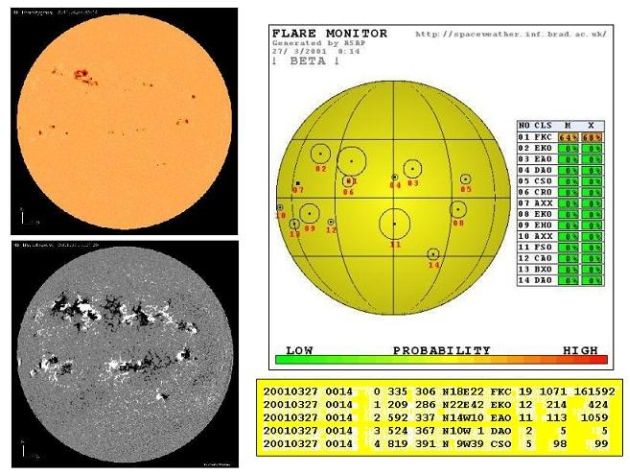| GSP Study Archive |
|---|
| Space Weather Studies |
| Applications Pilot Project |
| Feasibility Studies |
| CDF Space Weather Study |
| Past Workshops |
| Past Publications |

ASAP
Automated Solar Activity Prediction
Developer
University of Bradford (UOB), Space Weather Research Group.
Technical Group
Ionospheric Effects & Activity Forecast
SDA objective
Automated real-time prediction of Solar flares using image processing and machine learning- based system
Products
- Near-real time detection and classification of sunspot groups.
- Forecasts of solar flares.
Link to Project WebSite
SDA description
The Automated Solar Activity Prediction (a.k.a ASAP) is a computer system that is designed to predict significant flares (the figure below shows the currently completed part) and CMEs in near real-time. ASAP currently works for flare prediction and further work on CMEs continues.
SOHO/MDI Continuum and Magnetogram images are used to detect sunspots and find their McIntosh classifications. These classifications are fed to the learning models to provide real-time predictions for the possible occurrence of flares. The flare prediction system can be described in three stages:
1. Sunspot grouping.
a. Detection of sunspot candidates from MDI continuum images using morphological image processing algorithms.
b. Detection of active region candidates from MDI magnetogram images using morphological image processing algorithms. The MDI magnetogram images show the magnetic fields of the solar photosphere, with black and white areas indicating opposite magnetic polarities. These areas are detected separately and combined afterwards to determine the active region candidates.
c. Applying a “region growing” algorithm to combine sunspot and active region candidates.
d. Using neural networks to combine regions of opposite magnetic polarities to determine the exact boundaries of sunspot groups.
2. McIntosh-based classification.
a. Extracting local features from every sunspot in every group using image processing and neural networks.
i. Extracting the length, tallness, and area of the sunspot.
ii. Using neural networks to decide the type of penumbra (i.e., Mature or Rudimentary) and whether the sunspot is Symmetric or Asymmetric.
b. Extracting features from each sunspot group using image processing. The extracted features are length, largest spot, polarity and distribution.
c. Applying all the extracted features to a decision tree to determine their McIntosh classification.
3. Flare prediction using Neural Networks.
a. The publicly available NGDC sunspots and flares catalogues were investigated to associate flares with the sunspots that caused them. The association is determined based on the location (i.e., same NOAA number) and timing information.
b. A Neural Networks is optimised, trained using this association information. The input for NNs are composed of sunspot group classification (McIntosh) and sunspot areas.
c. The neural networks are combined to produce a hybrid system to give flaring probability of each sunspot group and their flare intensity probabilities.
Contact
Rami Qahwaji
|
Email: |
R.S.R.Qahwaji@Bradford.ac.uk |
Tufan Colak
|
Email: |
T.Colak@Bradford.ac.uk |
